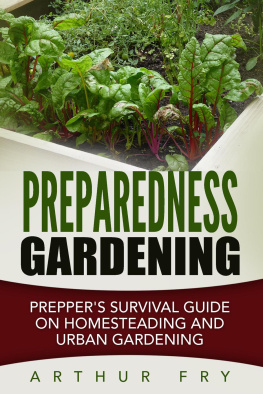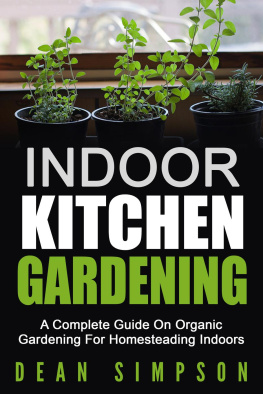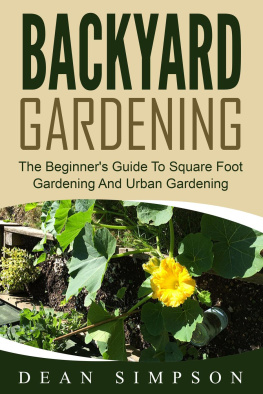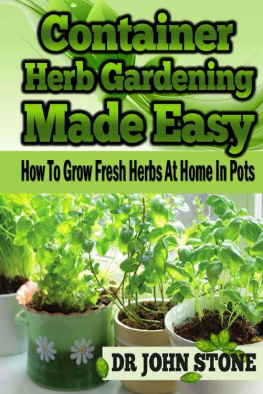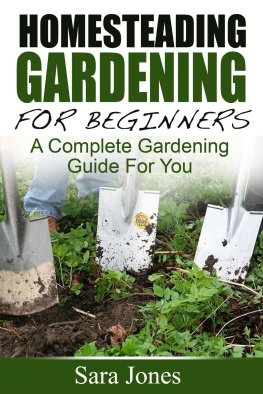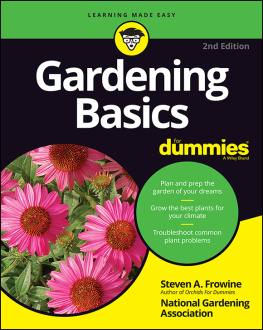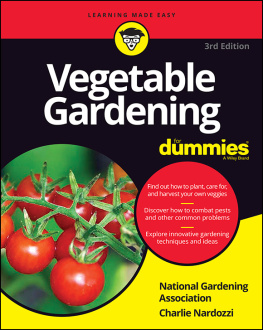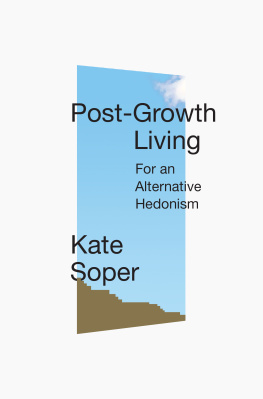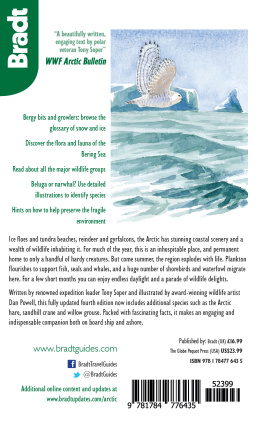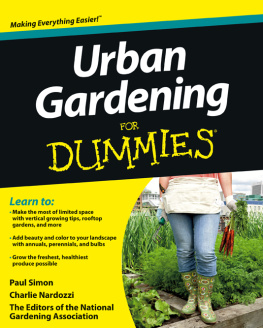John Soper - Bio-Dynamic Gardening
Here you can read online John Soper - Bio-Dynamic Gardening full text of the book (entire story) in english for free. Download pdf and epub, get meaning, cover and reviews about this ebook. publisher: Souvenir Press (Perseus), genre: Religion. Description of the work, (preface) as well as reviews are available. Best literature library LitArk.com created for fans of good reading and offers a wide selection of genres:
Romance novel
Science fiction
Adventure
Detective
Science
History
Home and family
Prose
Art
Politics
Computer
Non-fiction
Religion
Business
Children
Humor
Choose a favorite category and find really read worthwhile books. Enjoy immersion in the world of imagination, feel the emotions of the characters or learn something new for yourself, make an fascinating discovery.
- Book:Bio-Dynamic Gardening
- Author:
- Publisher:Souvenir Press (Perseus)
- Genre:
- Rating:4 / 5
- Favourites:Add to favourites
- Your mark:
- 80
- 1
- 2
- 3
- 4
- 5
Bio-Dynamic Gardening: summary, description and annotation
We offer to read an annotation, description, summary or preface (depends on what the author of the book "Bio-Dynamic Gardening" wrote himself). If you haven't found the necessary information about the book — write in the comments, we will try to find it.
Bio-Dynamic Gardening — read online for free the complete book (whole text) full work
Below is the text of the book, divided by pages. System saving the place of the last page read, allows you to conveniently read the book "Bio-Dynamic Gardening" online for free, without having to search again every time where you left off. Put a bookmark, and you can go to the page where you finished reading at any time.
Font size:
Interval:
Bookmark:
Appendices:
John Soper met the Bio-Dynamic work before the War and has remained faithful to it ever since. In East Africa, while in the Colonial Agricultural Service, he broadcast gardening talks both in English and Swahili, and was chairman of the Dar- es-Salaam horticultural society. In his work in the Colonial Service he always took a broad view, advocating a healthy organic way. He has often told me that much that was done in those days has now sadly disappeared. Wherever he lived he always had a garden. After his retirement he took up work for the Bio-Dynamic Agricultural Association.
This book is the fruit of all those years. It is that excellent kind of booka mans own experience. It will, I hope and believe, be valued by those interested in Bio-Dynamic gardens and their background for many years to come.
DavidClement
formerlyChairman,
Bio-DynamicAgriculturalAssociation
When a second edition of this book was proposed, it was suggested that more should be added on cosmic influences and herbs as there is a growing public interest in these subjects. We have therefore enlarged the descriptions of the bio-dynamic preparations and their effects, as this surely adds much interest and understanding when using them.
Taking account of cosmic influences is one of the main differences between bio-dynamic and organic methods. The earth is on the downward path of dying and is being so abused that it needs more positive help than merely avoiding the use of chemical fertilisers and herbicides and reverting to older, traditional methods. These are good as far as they go, but in order to enliven the declining forces in nature, an intelligent use of the bio-dynamic preparations brings new possibilities to farmers and gardeners.
We have also added sections on weeds and insect and animal pests. These are more fully treated in Maria Thuns publications to which we have referred.
The book remains substantially as John Soper wrote it, but additions have been made to the text to bring in new information, and completely new chapters are clearly attributed, such as that on herbs. The list of recommended varieties of fruit and vegetables has been revised and brought up to date by the bio-dynamic market gardener Jean Cormack and others, as some of John Sopers suggestions are no longer available. The added varieties have been marked with an asterisk as a guide to those familiar with the previous edition.
A few comments have been added to an enlarged book list to assist readers in their selection, and addresses have been provided of those publishers whose books are not easily obtainable through the normal retail outlets.
B.Saunders-Davies
1996
We would like to thank the following for their help in preparing the revised edition of this book:
Jean Cormack for her advice on varieties of fruits and vegetables suitable for bio-dynamic techniques;
Tabitha Parsons for her drawings of the preparation plants;
James Anderson for contributing photographs to illustrate bio-dynamic gardening in practice.
In an address to those attending his course of lectures on agriculture Rudolf Steiner explained that he was giving them a kind of alphabet, and that it would be up to each of them to make the letters into words which would apply to their own particular conditions of soil, climate, etc. He emphasised that he was speaking from his personal experience on small peasant farms, and he did not mention gardens at all. Moreover when he spoke of seasons he referred specifically to those which prevail in a continental climate. Dr E. Pfeiffer, Erica Riese, Maria Thun and others have made many useful words out of the new alphabet, words applicable to gardens, but again under continental conditions. But the insular climate and many of the soil types of Great Britain are not quite the same as those on the continents of Europe and North America, nor have we been fortunate enough to have had anything approaching a research station with workers devoted to the making of British words. Nevertheless a certain amount of scattered experience has been gathered by a number of gardeners over the years since the Agriculture Course was first brought over to Britain in the early 1930s, and many people feel that these threads need to be brought together. This I have now tried to do.
In writing the book I have had in mind especially those who may be coming to gardening for the first time and also those more experienced gardeners who are coming to bio-dynamics for the first time. The chapters dealing with individual crops do not purport to be a complete guide in every detail; I have concentrated more on aspects which, from personal experience, may be at variance with the advice given in some standard text books. I have also described many of the commoner troubles which may arise in even the most harmonious gardens from time to time, and have made suggestions for preventing them or for dealing with them if they do occur. A great deal more remains to be learned, so in the final chapter I have collected several instances where some preliminary observations seem to be worth following up; other possible lines of work will no doubt occur to readers. In the present circumstances of the Bio-Dynamic Agricultural Association in Britain advances in understanding basic principles and in devising techniques for applying them can only be made by co-operative effort. Readers are therefore invited to send particulars of any significant observations and trials to the Secretary of the Association or to the Editor of StarandFurrow.
This book could not have been written without the assistance of the late George Corrin, the Associations Consultant. Several important passages in the text are slightly paraphrased extracts from articles which he wrote, and he put his wide experience unstintingly at my disposal throughout. To him we all owe a deep debt of thanks.
JohnSoper
Clent
June1982
More and more people today are becoming convinced in their hearts that the world which we see and hear around us is not the only one; behind it and beyond the range of our senses there must be other worlds which underlie, inform, permeate and organise all our natural surroundings. The truth of this inner feeling is supported by the experiences of seers throughout the ages and in particular more recently by the revelations of Rudolf Steiner. Such an inner realisation is stronger and more far-reaching than the instinctive reaction of those who appreciate the damage being done to the earth by technology both in agriculture and industry, but who are trying to solve the problem simply by a return to more natural methods; they are still thinking with an onlooker substance-bound consciousness. The former outlook prompts one to begin studying nature and life in terms of processes, functions and dynamic qualities rather than in terms of mere matter. And so one comes to see that in nature cosmic factors have to be taken into consideration, and that Spirit is the original creator of matter, penetrating into its essential being and all its activities. Our plants and animals come to be seen as organisms manifesting themselves in their own right, not subject merely to chemical and physical laws, but also to all the unseen forces and influences streaming out from the earth and in from the universe.
It then has to be acknowledged that we ourselves, in our physical bodies, are part and parcel of this whole. We are not just onlookers manipulating nature to suit our personal ends. The food which we eat, the water we drink, the air we breathe all bind us inseparably to the biosphere; to work effectively in this milieu we have to learn to think as participants. This is not easy, but there are several ways which can help towards this new approach to nature. First and foremost it is beneficial to start developing a sense of wonder, humility and reverence. We can begin to experience within ourselves the rhythm of the seasons and their varying moods. We can try to sharpen our powers of perception, especially by noting day by day the changes in a familiar scenethe clouds, the play of the light, the growth of selected plants, and so on. Then one can try to experience the development of the annual plant by holding a viable seed in ones hand and watching it in imagination germinate, produce roots and leaves, flower, set seed and die. All this is a gradual process and many may not attain full transformation in a lifetime; but regular practice soon creates the frame of mind for appreciating and applying bio-dynamic methods.
Font size:
Interval:
Bookmark:
Similar books «Bio-Dynamic Gardening»
Look at similar books to Bio-Dynamic Gardening. We have selected literature similar in name and meaning in the hope of providing readers with more options to find new, interesting, not yet read works.
Discussion, reviews of the book Bio-Dynamic Gardening and just readers' own opinions. Leave your comments, write what you think about the work, its meaning or the main characters. Specify what exactly you liked and what you didn't like, and why you think so.



